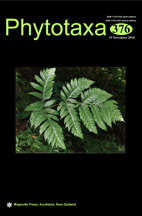Abstract
This is the first phylogenetic analysis of the Megamexican Bromeliaceae genus Hechtia and includes 82.6 % of the known taxa. We used plastid (ycf1, rpl32-trnL intergenic spacer), and nuclear (PRK) DNA regions, as well as morphological characters. We generated 244 new sequences for a total of 62 taxa (including 12 species of the outgroup). Results of combined data using parsimony and Bayesian inference reveal the monophyly of Hechtia, as well as identify five well supported clades: (1) a clade (H. tillandsioides complex) as the sister group to the rest of Hechtia; (2) a clade including the species of the H. guatemalensis complex, distributed in Southern Megamexico; the remaining taxa of the genus are retained in a clade which consists of three well-supported clades; (3) the H. glomerata complex distributed in the Gulf of Mexico drainage; (4) a clade of two species (H. deceptrix and H. epigyna) that share an inferior ovary and are distributed north of the Tehuantepec Isthmus in the Sierra Madre Oriental; and (5) an internally poorly resolved clade with the remaining species containing several well-supported, geographically restricted clades. At this time it is uncertain what part of Megamexico was first invaded by the ancestor of Hechtia. Regardless, it becomes clear that from the original point of invasion in what is now Megamexico, it radiated into restricted geographical realms with secondary radiations occurring within them, which resulted in some recurrent particular evolutionary trends most likely associated with the invasion of dry, highly seasonal climates, or cooler areas subject to occasional frosts. Lateral inflorescences and flower morphology suggesting pollination syndromes other than melittophily (psychophily/trochilophily) have evolved more than once in Hechtia.

